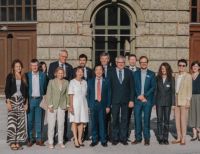The new Center for Sustainable Future Mobility (CSFM) will launch on 6 May with a kickoff symposium at ETH Zurich (see box). Kay Axhausen, Professor of Traffic and Transport Planning, will serve as the inaugural CSFM director. In a conversation with ETH News, he shares his view of the challenges ahead for transport and mobility research.
ETH News: What angle will the new Center for Sustainable Future Mobility adopt towards its field of research?
Kay Axhausen: Research at the CSFM will focus on the transportation of people and goods. We adopt an interdisciplinary approach, looking at what kind of technology and infrastructure, and which economic and political incentives, can help bring about sustainable traffic and transport systems. This also involves considering the people who generate traffic and use the various systems of transport. And we also examine other transport-related issues such as drive systems, emissions, pricing and policy measures. Here, we’ll be hoping to make use of the synergies generated from overlapping interests with colleagues at the Energy Science Center and the Institute of Science, Technology and Policy, all of whom have relevant experience in this field. That said, we’ll be focusing first and foremost on the systemic aspects.
What goals is the CSFM pursuing?
To develop overarching transport solutions that are genuinely sustainable, we need to draw together the approaches of individual research disciplines and work them into a whole. That’s one of our tasks at the CSFM. Our job is to create a shared awareness of the issues involved and to generate synergies and new ideas for society, for companies working in the sector, for the development of new services and also for policymakers. All the existing policy ideas in this area have been exhausted. That’s one of the main reasons for the current blockage in transport thinking right now.
What are the really pressing issues in this field?
That’s the topic of our kickoff event, where we’re planning to launch a dialogue on the challenges facing the sector and the role of research. Right now, we identify three areas where research needs to provide answers. First, there is the decarbonisation of transport, which currently operates largely on fossil fuels and is responsible for around 40 percent of greenhouse gas emissions in Switzerland. Then there is the trend towards digitalisation and automation, which is creating new opportunities and technological solutions all the time. It remains to be seen whether these can be developed and applied in such a way that will make transportation more efficient. And, thirdly, there is the question of which infrastructure and regional development policy can help bring about a sustainable transport system for the future.
Which modes of transport are currently growing in importance? And which will lose out following a shift to systems that are more sustainable and climate-friendly?
That’s a very open question right now. We’re no longer in the same situation as we were in the 1950s, when Switzerland and all the other OECD countries made a big bet on the car and over several decades invested heavily in building motorways – along with expanding the rail network for trains and trams. We’re now at a point where the future could take any one of a number of directions. That’s also due to the lockdown during the pandemic, along with working from home and the boom in e-commerce. This has made us question many of the things we thought we knew about driving distances and land use.
What is the relationship between transport policy and housing development?
The two need to be considered together: land use determines how far people need to drive, what modes of transport they use, the level of carbon emissions this generates, and what externalities arise – i.e. the impacts that no one pays or is compensated for. In the case of delivery traffic, for example, the number of kilometres driven depends on the number of warehouses and where they are located.
What’s the situation for private transport?
With private transport, driving distances depend on where people live and work. If, in the future, more people want to live in the country but still work in town, more of them are going to be driving longer distances. Any increase in long-distance transport is likely to expand the role of rail. Any growth in local transport, on the other hand, may give a boost to e-bikes.
















